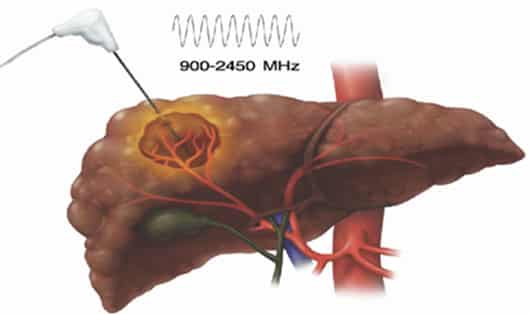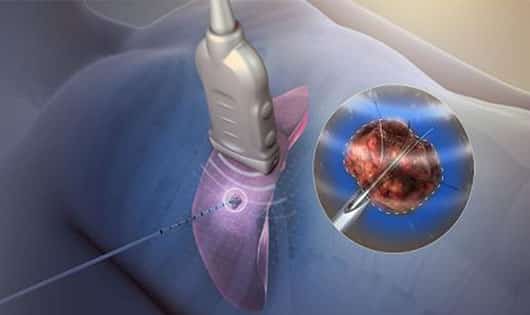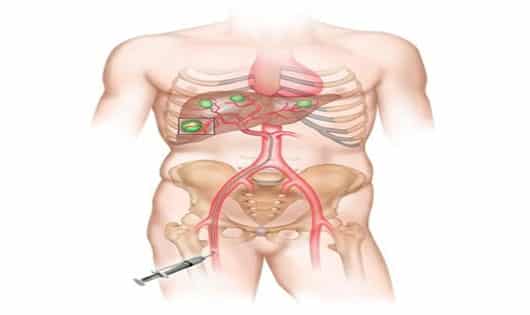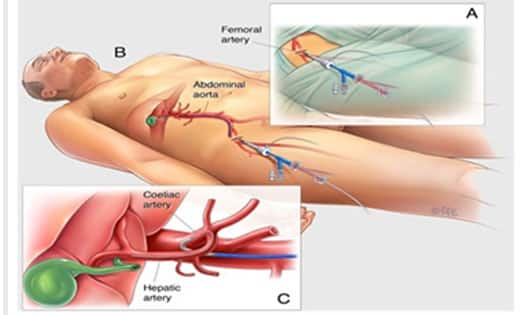Few patients (less than 20%) are amenable to resection and transplantation due to difficulties related to size, location and number of tumours, vascular and extrahepatic involvement and functional hepatic reserve due to cirrhosis. The ultimate treatment choice for the remaining 80% is interventional therapies.
In patients with early- or intermediate-stage disease, interventional therapies could control disease progression until definitive therapy or increase the patient’s eligibility for a curative treatment.
In advanced disease, the main aim of treatment is to control symptoms, prolong survival, and improve quality of life. Available interventional therapies include:
- RFA / MICROWAVE ABLATION,
- TACE, (TRANARTERIAL ARTERIAL CHEMO EMBOLIZATION)
- TARE (TRANARTERIAL ARTERIAL RADIO EMBOLIZATION)
ADVANTAGES?
In more advanced cases non surgical / minimal interventional procedures like RFA, MWA, TACE AND TARE can be done either as theurapeutic / supportive / bridging procedure for liver transplant, helping you live longer with better quality of life. They are more selective forms of liver treatment as compared to traditional whole body chemo or radiation where the side effects are more. Here the side effects are very minimal / no side effects and patients can go back home in a day
RADIO FREQUENCY ABLATION / MICROWAVE ABLATION:
The types of thermal ablation available are hyperthermic [radiofrequency ablation (RFA), microwave ablation (MWA).
Book An Appointment


- Here a special needle is introduced into the tumor after anesthesia , under image guidence either usg scan or ct scan or both.
- Needle is positioned in the centre of the tumor and certain heat is given so as to totally burn of the lesion / charring the tumor. Its as good as removing the tumor from the body but with out surgery, leaving the normal liver intact and untouched.
Patient goes back home the same day doing his regular day to day activities from the next day.
TACE, (TRANARTERIAL ARTERIAL CHEMO EMBOLIZATION)


TACE is a selective and focussed chemotherapy directly to the trageted organ / cancer lesion unlike the general / systemic chemotherapy as like conventional method. There by minimising the side effects and selective and targeted delivery of adequate quantity of drug to the tumor cells.
Also cutting of the blood suppy to the tumor cells which is the primary reaon for rapid growth of tumor size.
Delivery of chemotherapy and synthetic materials called embolic agents into a blood vessel feeding a cancerous tumor to cut off the tumor’s blood supply and trap the chemotherapy within the liver tumor.
This delivery of drug and particles is done by angiography / iv cannula kind of technique using small tubes and wires introduced through line placed in the hand / leg in a specialised angio suite.
Throughout the procedure is awake, and can see whats happening on the screen. Absolutly NO PAIN/ NO SUTTING OR SUTURE / NO PAIN technique and the pt can go back home on the same day. Can reseume regular activities from the next day.
Chemoembolization may be used as a standalone treatment or in combination with surgery, ablation, chemotherapy or radiation therapy.
Is chemoembolization the same as chemotherapy? / ADVANTAGES
Chemoembolization and chemotherapy both use cancer-fighting drugs to treat tumors. But there are a few differences:
- CHEMOEMBOLIZATION DELIVERS THE DRUGS DIRECTLY TO THE TUMOR. With standard (SYSTEMIC) CHEMOTHERAPY, THE DRUGS TRAVEL THROUGHOUT YOUR BODY VIA YOUR BLOODSTREAM.
- This treatment uses a HIGHER DOSE of chemotherapy than systemic chemotherapy. Because the drugs go directly into the tumor, you’re less likely to experience severe SIDE EFFECTS.
TARE (TRANARTERIAL ARTERIAL RADIO EMBOLIZATION)

(TARE) is an extention of TACE, where instead of chemo drug, radioactive drug is used for injection into the tumor. It is a combination of Radiation Therapy and Embolization – a minimally invasive treatment in which blood vessels are blocked off to prevent blood flow. In TARE, tiny beads of glass or resin known as microspheres loaded with a radioactive compound are administered inside the blood vessels that are feeding a tumor so that the supply of blood to the cancer cells can be blocked off. they deliver a high dose of radiation to the tumor without affecting the normal tissues.
TARE is a palliative treatment (it means that it does not provide a cure) that helps slow down the disease growth and also helps alleviate symptoms. It is often used as a treatment option for patients who cannot undergo other treatment options such as liver surgery or liver transplantation.
It is a two sitting procedure where in first sitting angiography is done and MAA is injected to access the patient fitness for the TARE procedure and also radoactive dose calculation. This helps simulate the exact distribution of the TARE particles in the liver before it is actually injected. The patient is then discharged from the hospital. The radioactive dose is ordered and the pt is admitted within a week for the second sitting for the actual procedure. Here in this procedure the actual radioactive drug is delivered angiographically directly into the tumor using the tubes inrtoduced through groin or hand as like in cardiac angiography. The drug gets trapped in the tumor and start emitting radiation to the tumor that kills it slowly.
Patient is discharged the next day to resume his day to day activities.
